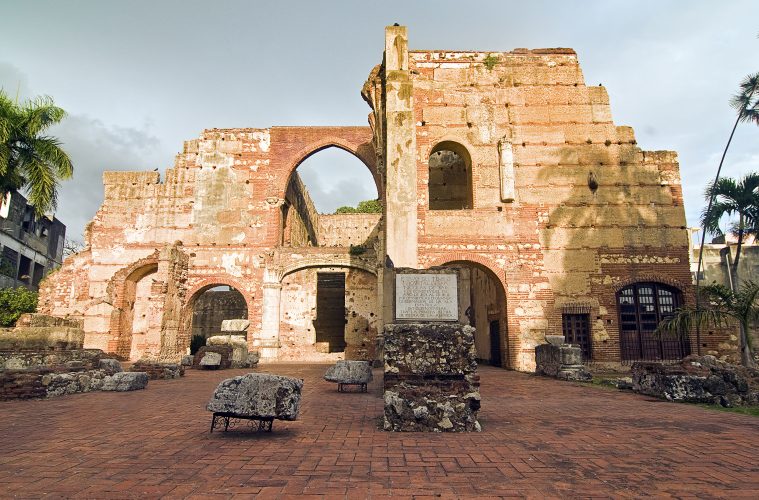Sipping sangria by the azure infinity pool on the roof-deck of the newly-opened Real InterContinental Hotel in Santo Domingo, I thought, “Who needs the beach?” Indeed, what this vibrant city lacks in nearby sea and sand (you must drive 2 hours or more to find a nice beach), it more than makes up for with its history, culture, fine dining, shopping, and nightlife.
Santo Domingo is the capital of the Dominican Republic on the south coast of the island of Hispaniola, shared by Haiti to the west. To get your bearings, take a historic tour of the cobbled Zona Colonial, the oldest European settlement in the New World and a UNESCO World Heritage Site. Christopher Columbus’s brother, Bartholomew, founded Santo Domingo in 1496 and the area’s grid pattern, serving as a model for many future towns and cities. Thanks to recent restorations, you can see many of the original, Spanish-style buildings, including the first cathedral, monastery, university, and hospital in the Americas: Saint Mary of the Incarnation Cathedral, Saint Francois Monastery, Saint Thomas Aquinas University, and San Nicolás de Bari Hospital. If you’re with children, consider touring the area on the chubby, white Chu Chu Colonial train, then walking down the picturesque pedestrian-only streets lined with shops, restaurants, bars, and cafes. A popular resting spot is the Plaza de Espana, filled with pigeons, running toddlers, and older men playing the squeezeboxes and hand drums.
One of the city’s top monuments is Columbus Lighthouse. Although the idea to erect a tribute to Christopher Columbus first arose in 1852, the project didn’t commence until 1923, when the Fifth International American Conference held in Chile approved the idea. This led to an international design competition, which British architect, Joseph Lea Gleave, won in 1931 for his giant, cross-shaped building, which wasn’t completed until 1992, due to political and financial reasons. Columbus Lighthouse not only stores the explorer’s remains, but has 63 exhibitions representing different world nations, and beams a giant cross of light into the night sky.
If you love museums, Santo Domingo has many, including little ones devoted to amber, rum, and cigars, which feature small exhibits and large gift shops. For excellent Dominican chocolate, visit Kah Kow museum in the old quarter, where you can watch a terrific film on the history of chocolate and see several exhibits, including a small factory, where you can pour liquid chocolate into molds to make your own chocolate bars. You’ll find more scrumptious chocolate goodies in the gift shop, as well as café, which sells chocolate drinks, bonbons, and desserts. The on-site Soap Lab even offers the chance to craft cocoa butter soap.
Other notable museums include Alcazar de Colon, originally the home of Diego Columbus, Christopher Columbus’s son. The exquisitely restored building now displays an impressive collection of European Late Medieval Renaissance art. Another gem is the Museum of Modern Art, filled with 20th century and contemporary Dominican art.
As for where to stay, it depends on your personality and style. The snazzy business district tends to feature sleek modern spots like the InterContinental surrounded with lots of restaurants, shopping and nightclubs. The Zona Colonial, however, leans more toward, historic boutique properties, like the Hotel Nicolas de Ovando Santo Domingo, housed in the former home of one of the city’s first governors and a UNESCO Word Heritage site.
Due to the Dominican Republic’s strong Spanish heritage, dining in Santo Domingo means lots of restaurants serving tapas, paella, and grilled meats. The island’s waters yield pristine fish and seafood and the shores grow luscious tropical fruits. Rice, bean, and potato dishes are popular, along with pre-Columbian Taino fare, such as deeply-spiced, tender goat meat stew. Dominican Republic beer makes a fine drink, as does local rum.
In fact, some great souvenirs to bring home, include Dominican Republic chocolate and rum, along with coffee and cigars, which you can see being rolled at street stalls. You’ll also find lots of jewelry made from local amber, black coral, and larimar, a beautiful pale blue stone unique to the Dominican Republic.
Getting to Santo Domingo is a snap—direct flights from Boston’s Logan to Santo Domingo take only four hours. This means you can leave in the morning and be sipping that sangria before the sun goes down.

